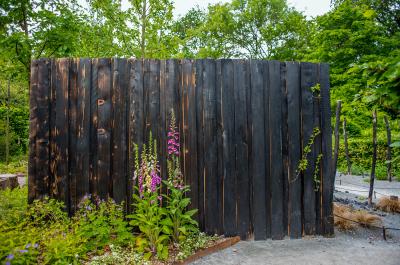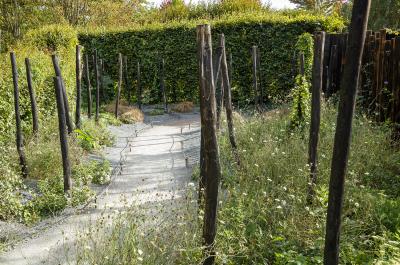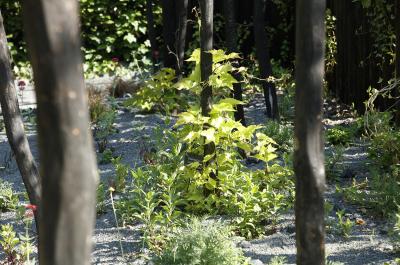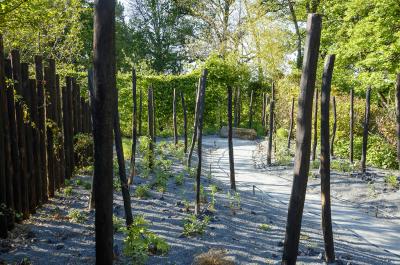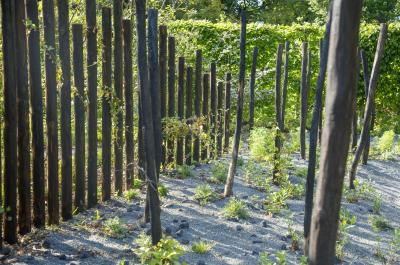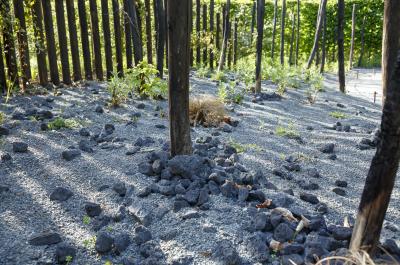08. Cendres fertiles
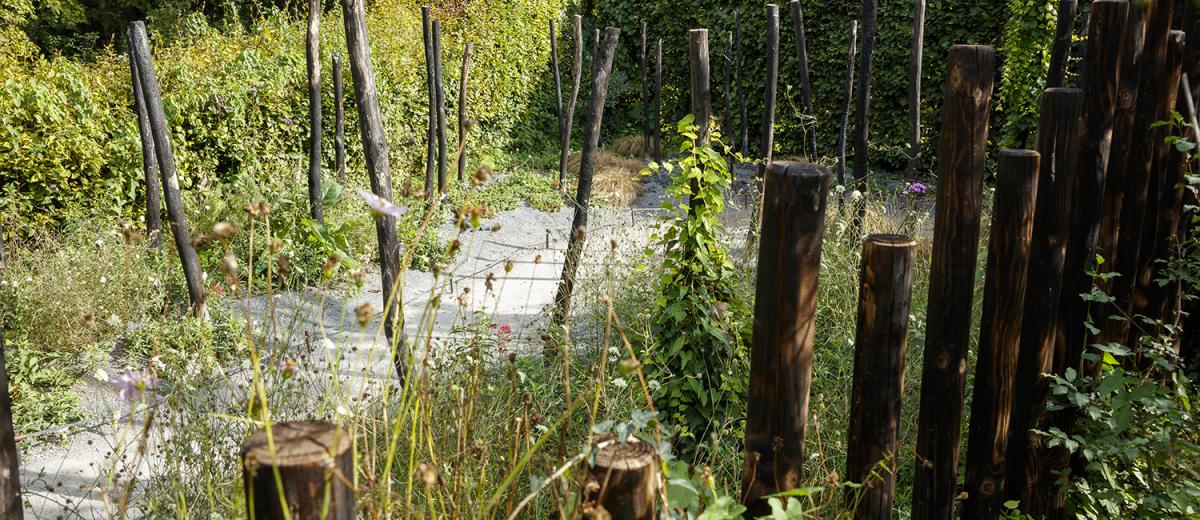
The lives of our young adults have been marked by their confrontation with the degradation of our natural environment. Recent months and years have been all the more impactful as this degradation has become increasingly rapid and radical, with fires destroying many of our forests. Without turning away or giving in to sensationalism, this creation tells the tale of a garden wounded by the spread of fire but in which plant dynamics are now on the road to recovery. After refocusing their minds in an “airlock” on the garden’s threshold, visitors make their way into a charred forest whose blackened trunks contrast with the lively green climbing plants that cover them and the young forest plants and hardy species growing in the volcanic rock soil.
A wooden barrier divides the garden into two parts, marking the border between the awakening forest and the restored forest, between black and white and colour. To cross it is to make a leap several decades into the future: young trees are now very much alive, spreading their branches and budding foliage. They accompany us to the garden’s exit, where a maple tree will brighten up the last hours of daylight during the autumn. If it’s used properly, ash can be a rich natural fertiliser. The garden rises from its ashes. There’s room for hope.
DESIGNERS
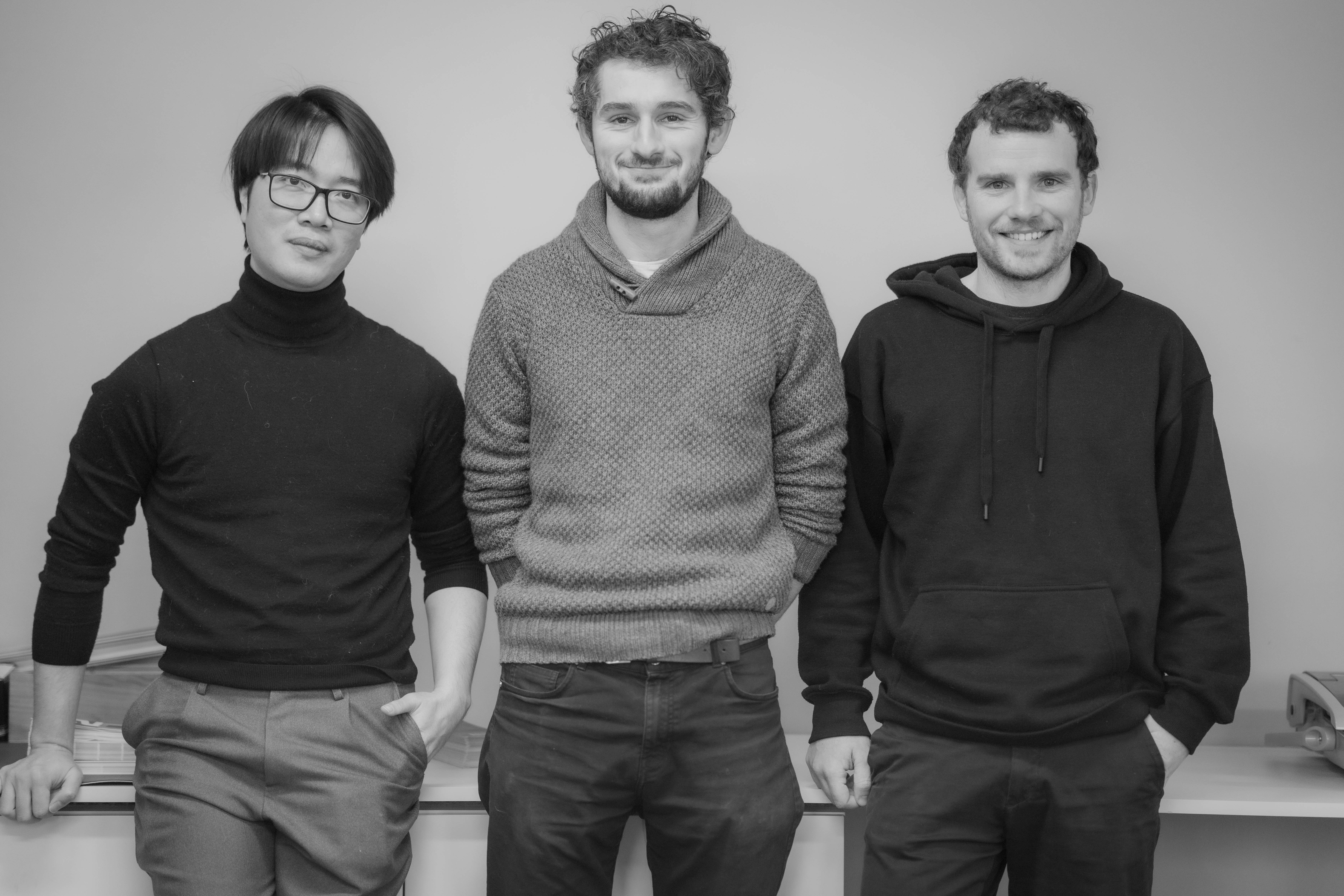
Robin Eymieux is an urban planner with a degree from Paris 1 Panthéon-Sorbonne University. He spent his childhood near the city of Tours, between the Cher and the Loire, in stimulating natural and historical surroundings. The closeness of the Château de Villandry gardens, the vitality of the riverbank plant life (now much degraded by recent climatic disturbances), and his family’s relationship with gardening all marked his imagination. He developed a taste for illustration, sketching and botany in parallel with his schooling. After non-specialist studies in urban and land-use planning, he sought to develop his knowledge of landscaping by taking a practical, hands-on approach to the craft. He joined the Champ Libre cooperative company with a view to diversifying his practice, deepening his love for the subject and honing his skills in direct contact with landscape designers. It has provided him with opportunities to work on conversion of urban spaces through landscape design in several Norman municipalities, including in Beuzeville, on conversion of a former manorhouse garden into a public park. The circumstances of his professional life have also taken him to the “Loire Châteaux” region, in particular to the Lochois, where he studied how best to convert an extensive floodplain of poplar plantations in grasslands and reedbeds for use by walkers and as venues for open-air art exhibitions. In the same vein, his current wish is to do what he can to contribute to the adaptations required to cope with global changes, through plantings, drawings and social contacts.
Antoine Debray is a landscape designer who graduated from Marseille’s National Higher School of Landscape (ENSP) in 2018, and an urban planner with a degree from the Institute of Urban Planning and Regional Development (IUAR) in Aix-en-Provence. After specialising in botany during his schooling in the Toulouse area, he went on to study at higher education institutions in Antibes’ Mediterranean climate and then in Marseille. He gradually developed his sensitivity to landscape and design, exploring the South of France’s landscapes from the Pyrenees Mountains to the creeks of Marseille. With a view to enriching and diversifying his approach to design, he spent some of his time as a student in Edinburgh in Scotland in order to acquaint himself with British methodologies, and then, for similar reasons, set off to Central America to explore Cuban and Mexican landscapes. He joined Champ Libre in 2021 and became a project leader. He develops design projects with naturalistic plant palettes and modest ambitions with regard to ecological diversification and improvement of living landscapes. During his first year at the ENSP, a series of fires devastated Marseille’s creeks and blackened the city’s skies. Over the course of years and his botanical excursions, those disasters helped him discover the natural resilience of Mediterranean plant life in the face of fire, and the gradual evolution of its landscapes.
After graduating in architecture in Hanoi, Xuan Tuan Nguyen travelled to Paris to further his knowledge of landscape and then of urban planning. He had been fascinated by nature ever since he was a little boy and, during his architectural studies in Hanoi, developed a keen interest in the subject of transition between urban areas and human activities and the vegetation that surrounds them. That was why he wanted to learn more about and assimilate the urbanistic and landscaping visions developed in Europe, a desire that finally pushed him to move to Paris and continue his landscape studies at the Higher School of Garden Architecture (ESAJ), and his urban planning studies at Gustave Eiffel University’s French Urban Planning Institute (IFU). His various professional influences are also enriched by his dual French-Vietnamese nationality. He joined the Champ Libre cooperative company in 2014, becoming landscape and urban planning project leader, with a view to exploiting his double culture in greater depth. His origins are expressed in the plant composition of the projects he designs, as well as in their aesthetics, simplicity and natural character. He also thrives on alternative projects, such as the Street Food Festival in Lyon, where his passion for growing Asian herbs was on full display, and on his activity as a hybrid architect, which he continues to carry out on Vietnamese soil. Hence, Xuan Tuan seeks to combine the two worlds in which he has come into his own, developing a multicultural practice and taking care never to put human and plant constructions in conflict with one another.
